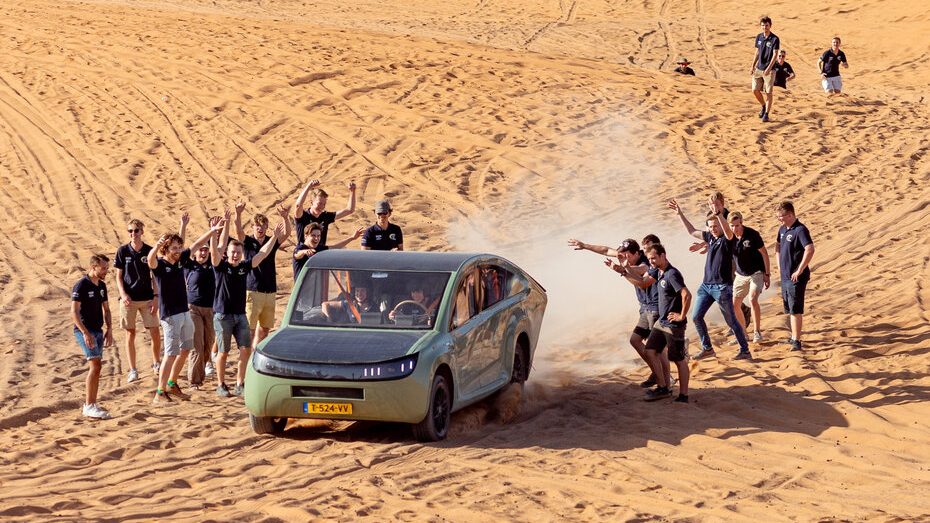The surge in popularity of zero-emission cars has been undeniable, but their reliance on charging infrastructure can be a significant limitation, particularly in remote areas. Enter Stella Terra, a khaki-green SUV designed to transform the electric vehicle landscape.
Stella Terra is the world’s first off-road solar SUV, developed by students at Eindhoven University of Technology in the Netherlands, reported CNN. The vehicle could be a game-changer for remote areas with limited charging facilities. What sets it apart? Its solar panels, adorning the sloping roof, power its electric battery, enabling it to travel long distances solely on solar energy.
Thieme Bosman, the events manager for the team, believes that Stella Terra could play a crucial role in connecting remote areas where roads are less developed and energy grids are not as reliable. Moreover, it could prove invaluable in emergency aid and delivery operations.
To put Stella Terra to the test, the team embarked on a journey through the diverse landscapes of Morocco, covering over 1,000 kilometres, from the northern coast to the Sahara Desert in the south. Bosman explains, “Morocco has a huge variety of landscapes and different surfaces in quite a short distance.” The vehicle encountered various terrains, showcasing its off-road capabilities.
Stella Terra features
The road-legal Stella Terra boasts a top speed of 145 km (90 miles) per hour. On a sunny day, its battery range extends to around 710 km (441 miles) on roads and approximately 550 km (342 miles) off-road, depending on the surface. Cloudy conditions may reduce the range slightly, but the solar panels provide a reliable power source.
Notably, Stella Terra exceeded expectations in terms of efficiency, proving to be one-third more efficient than anticipated. Its lightweight design contributes to its performance, ensuring it can handle rugged terrain while placing minimal stress on its suspension.
Stella Terra’s charging innovation
Electric SUVs typically require larger, heavier batteries due to their added weight, but Stella Terra’s unique design reduces these challenges. The team focused on maximising efficiency in every aspect of the vehicle. At just 2,645 pounds (1,200 kilograms), Stella Terra weighs approximately 25% less than the average mid-sized SUV. Its aerodynamic design minimizes drag, and lightweight yet robust composite materials further reduce its weight.
Bob van Ginkel, the technical manager for Stella Terra, points out, “One of the benefits of the solar panels on top is that we can have a much smaller battery because we are charging while driving.”
This innovation allows the vehicle to roam off-road without the need for charging points, providing drivers with unprecedented freedom.
To address the practicalities of long-distance journeys, Stella Terra incorporates features inspired by the solar-powered campervan previously developed by the university. The seats can fully recline to create a bed, making it suitable for extended trips. When stationary, the solar panels extend to maximize charging and double as an awning for shade, enhancing the overall experience.
Stella Terra Morocco off-road testing
In September, the Stella Terra team ventured to Morocco for extensive off-road testing. Starting in Tangier, they navigated the rugged Rif mountain range, dealing with steep ascents and descents, which marked the SUV’s first off-road challenge. Continuing their journey through Fes, they tackled mountain trails in Midelt, one of Morocco’s highest towns. The expedition ended in the Sahara Desert, where the Stella Terra faced looser, sandy tracks.
Despite encountering a steering system breakdown early in the trip, the team quickly found replacement parts at a local workshop, ensuring the journey continued without major interruptions. Bosman described the journey as an incredible experience due to the wide range of landscapes and terrains they encountered, creating a unique testing ground for the Stella Terra.
TUE’s automotive initiative
Eindhoven University of Technology’s automotive innovation lab has been at the forefront of solar-powered vehicle experimentation for over a decade, consistently producing concept cars years ahead of the market. However, transitioning from concept to mass production has proved challenging.
Previous initiatives like Lightyear, launched by university alumni, aimed to produce solar panel-fitted cars but faced financial difficulties. Stella Terra’s team remains optimistic, hoping their concept SUV could be mass-produced soon and inspire individuals and major automakers to rethink their designs and accelerate the transition to sustainable vehicles.
Thieme Bosman explains, “We aim to inspire not only everyday people but also the automotive industry, the Ford and Chryslers of the world, to think again about their designs and to innovate faster than they currently do.”/TISG
Guide to Starting a Business in Singapore: Essential Costs and Steps for Entrepreneurs

